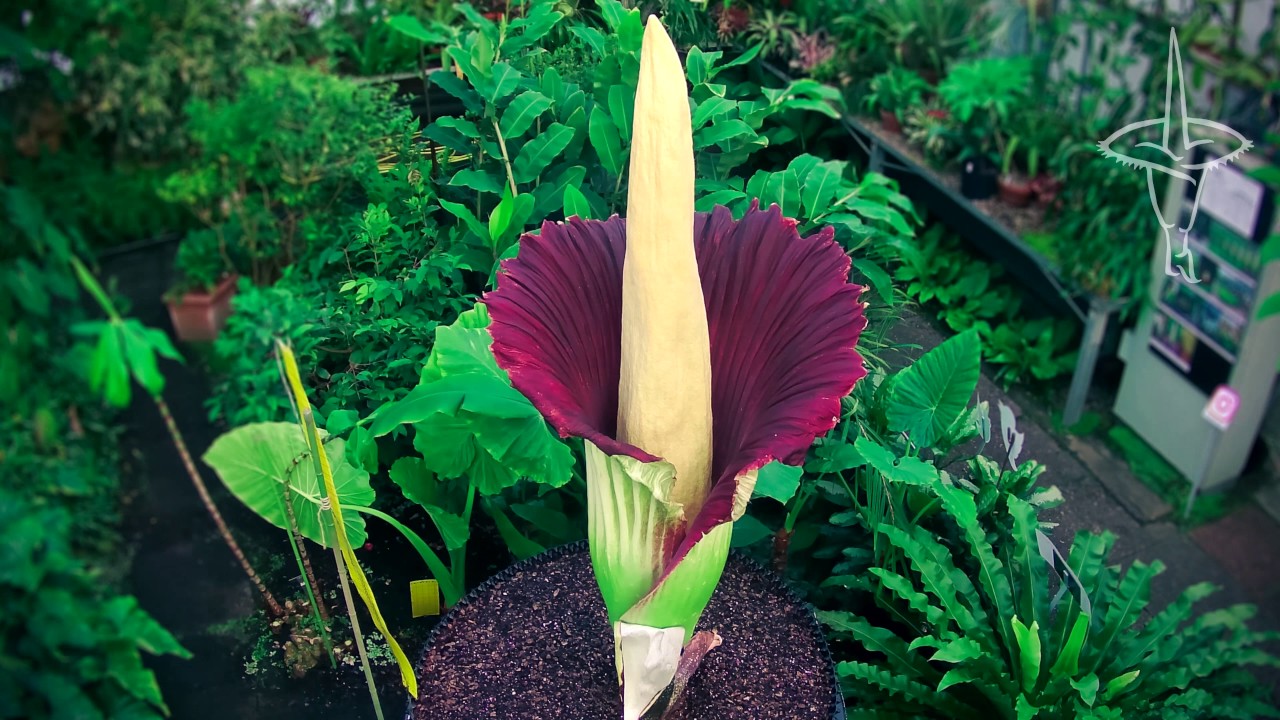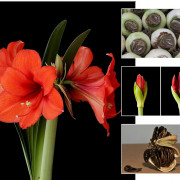Amorphophallus flower indoor - home care
Content: [Hide]
Among lovers of home greenhouses there is a group of collectors of "exotic plants" - unusual plants that are not typical for the area. It is difficult to cultivate such plants, but it is honorable. Growing amorphophallus, a beautiful and whimsical flower, at home is an interesting quest for a florist.
Amorphophallus: what it looks like, which family it belongs to

Giant tropical flower
Among 170 species of tropical and subtropical plants of the Aroid family (Araceae), amorphophallus stands apart - "shapeless phallus" if translated from Greek. It is a tuberous deciduous plant with the smell of rotten eggs and fish, but exudes "amber" only when touched.
Hence the numerous names: cadaveric flower, amorphophallus, snake palm, voodoo lily. One of the nicknames is the language of the devil.
The size of the plant can be from small (placed in a pot on the windowsill) to gigantic, which is used to build special greenhouses. The culture grows from a spherical tuber resembling a beet or grapefruit, weighing up to 5 kg. Plants have a long dormant period, only some species are evergreen herbs.
Domestic amorphophallus is a short-lived ephemeroid. Each year, one leaf on a long petiole, dissected like a palm tree, grows from the tuber. It is several meters wide and lasts the entire growing season. In the next season, the leaf plate becomes taller and even more dissected.
It blooms once a season - it throws out an elongated oval ear, covered with inflorescences, from which round fruits with seeds then ripen. Color - orange-red, white, blue.

Flower in natural environment
Spread:
- In the wild, the plain culture grows in the tropics and subtropics of Africa, Asia, and Australia.
- It can also be found on the islands of Java, the Philippines, Fiji, the Moluccas, Borneo.
- The widespread distribution of the world's largest amorphophallus flower is observed in India, China, Japan, Bangladesh. It is also found in the countries of Laos, Cambodia, Vietnam.
Most species grow on destroyed foundations - secondary forests, limestone rocks, littered places.
Varieties
Several types are suitable for home cultivation:
- Amorphophallus konjac. In Asian countries, amorphophallus cognac is not a flower for decorative purposes. There, the bulbous tubers of the peony-leaved amorphophallus are used in cooking. They are ground into flour, from which side dishes, sauces, and seasonings are made. A dietary product (the taste resembles a potato) helps a person suffering from high blood sugar, cleanses the body of toxins, and fights obesity.
- Amorphophallus titanic or titanium. The greenhouse plant is obtained by selection. It looks like a huge inverted bell up to 3.5 m in diameter and up to 2 m high. A giant is grown from a tuber weighing 20-25 kg.
- Bulbous variety. This amorphophallus is more like a houseplant than other species. It is low - up to half a meter, flower size - up to 30 cm, the ear is evenly colored pink.

Cognac variety
Features of home care
Home flower gardeners compete to grow the largest specimen. The size of the flower depends on the variety and inspection. The most important rules of care are as follows.
Temperature
Large varieties that are kept in greenhouses, during the period of intensive growth and flowering, require + 25-28 ° C - conditions close to natural. For bulbous plants, the usual room temperature is enough - +24 ° C.
After flowering, the pot is taken out into a cool room - + 10-13 ° C, or the thermometer in the greenhouse is reduced.
Lighting
In the wild, amorphophallus is a flower that grows under the shelter of tall tropical forest vegetation, but there is enough sun and air. Houses also provide light, but diffused - on the southern windowsills, flower growers shade plantings.
Watering
Constant moisture in the substrate is an important component of active growth and development of culture. But the water should not stagnate in the container, so good drainage is made in the dishes. The tap liquid is defended to evaporate the chlorine.
Spraying
An obligatory daily procedure is spraying the leaf so that it does not start to turn yellow around the edges. The water is defended and heated, otherwise the plant will receive a shock.

In the greenhouse
Humidity
Air saturation with moisture is maintained by spraying from a spray bottle or automatically.
The indicator should be above average - 70-80%.
Priming
The soil is selected in the shops of the agricultural complex - a universal flower substrate, or soil for Saintpaulias.
Top dressing
During the growing season, the flower culture is fed with mineral and organic compounds. The emphasis is on the increased phosphorus content. The plant spends a lot of energy on vigorous growth and flowering, so it is fertilized every 10 days.
Pruning
The beauty of home greenhouses does not need to be cut off. When a bud appears, it is pinched so that there is no unpleasant smell. The flower and leaf die off naturally. Parts that have dried up before wintering are removed.
Features of care during the rest period
By autumn, the flower stops growing, the leaf withers. Watering and feeding is gradually reduced, the leaf is cut off at the very ground.
In "hibernation" amorphophallus is 5-6 months. The tuber can be left in the pot. In a cool place, the soil is lightly sprayed every 10-12 days.
If it is decided to remove the root, then it is shaken off the ground, damaged and rotten places are removed. There may be children on the rhizome, which are separated for reproduction.
The tuber is disinfected in a solution of potassium permanganate for 2-3 hours, dried.
When and how it blooms
A single flower appears before the leaf, pleases with a non-standard exotic look for 2 weeks. The tuber gives it a lot of nutrition, therefore it greatly decreases in volume. After flowering, the plant rests for 3-4 weeks, then forms a leaf.
The structure of the flower is complex:
- The inflorescences consist of an elongated corrugated or smooth cob and a "blanket".
- The tube at the base is covered with scales or hairs - this is a trap for pollinating insects.
- The monoecious plant has staminate (male) and pistillate (female) flowers.
- At the end of the ear is a horizontal or vertical sterile appendage.
Pollination occurs on the day the cob is opened. The smell of decaying flesh attracts insects, which are caught in the ingenious traps of the cob. Collect the pollen of the staminate flower, transfer it to the female. Self-pollination is excluded, since female flowers open later than male flowers. For the ovary of fruits, nature released the amorphophalus snake tree one day.

Amorphophallus
How amorphophallus multiplies
You can propagate the plant using the methods familiar to the gardener:
- Children. When the tubers are dug up and sent for winter storage, children are found.They are broken off, planted in containers.
- By dividing the rhizome. In the spring, as soon as the first shoots appear, the onion is dug up, divided into parts. Roots and buds of growth should remain on each fragment.
The seed method is not rational. Seeds, sown in containers with a suitable substrate, germinate quickly - in 5-10 days. You need to take care of the usual seedlings. But flowering will be in 5-7 years.

Plant tubers
Transfer
As the snake tree grows, the amorphophallus is transplanted by the transshipment method. This is done in early spring, when the sprouts are just emerging. The substrate is selected with a composition for aroid plants: peat, humus, leafy earth, sand.
Step-by-step description of the process:
- A thick layer of drainage is poured onto the bottom of the container.
- Half-fill the pot with soil, add sand.
- A tuber is placed in the middle.
- Fall asleep with the rest of the soil.
After transplanting, the plant is watered abundantly.
Diseases and pests
The tropical "guest" is resistant to diseases and pests typical of flowers. But from excess moisture, fungi, worms and nematodes appear. This explains why amorphophallus does not bloom. The soil is periodically disinfected from pests.
Aphids and spider mites may appear on the leaves - insecticides are used against them, as well as against scars, warty formations, and injuries.
Rotten roots are removed before wintering so as not to infect the flower with pathogenic flora and bacterial infection.
The amorphophallus plant is a spectacular flower that surprises and gives great aesthetic pleasure with its appearance. Botanists consider it the largest flower in the world. Meanwhile, there are compact indoor specimens, which are not difficult to care for: watering, light, the right temperature and humidity.















